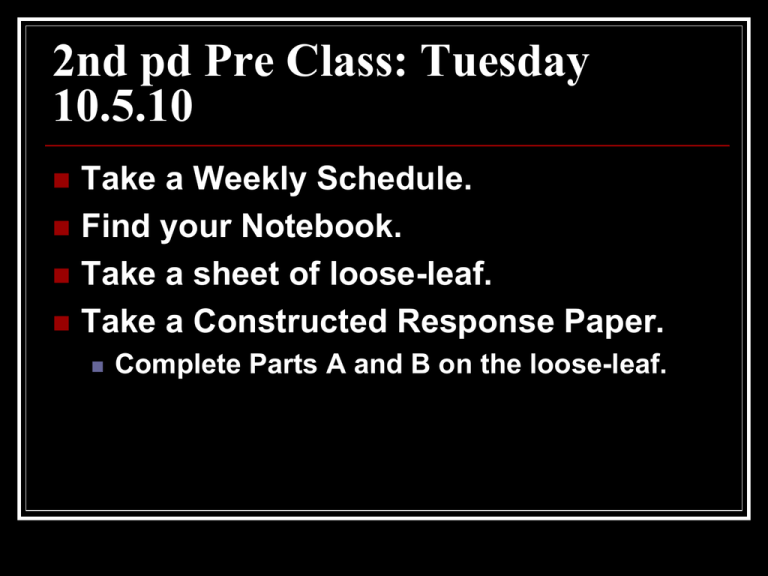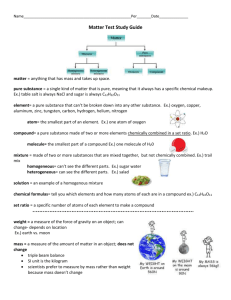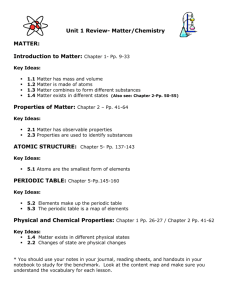Chapter 2 - BiologyIsFun
advertisement

2nd pd Pre Class: Tuesday 10.5.10 Take a Weekly Schedule. Find your Notebook. Take a sheet of loose-leaf. Take a Constructed Response Paper. Complete Parts A and B on the loose-leaf. Agenda. CR #4 Notebooks!!! Tuizzes! Weekly Schedule. Introduction to Chapter 2 notes. Pre Assessment and Concept Review. Chapter 2: Matter. Monday 10.4.10 Matter Matter is anything that has mass and occupies space. Air, desk, humans. Light and sound? Matter is made up of Elements & Atoms. Element- cannot be separated or broken down into simpler substances. (Example: Aluminum(Al) , Gold (Au)) Atom- smallest unit of an element that maintains the properties of the element. (example: single atom of Aluminum). Compound- substance made up of atoms of 2 + different elements. (Example: Nylon, Aspirin: C6H8O4). Nylon! A compound made up of Carbon, hydrogen, nitrogen, and oxygen atoms. Compounds have unique properties. Chemical formulashows how many atoms of each element are in a substance/compound Chemical formula for Water: H2O Molecules Molecules- smallest unit of a substance that keeps all the physical and chemical properties of the substance. When atoms combine and act as a unit! Can be atoms of the same or different elements. Pure Substances vs. Mixtures. Pure Substancematter with fixed composition and definite properties. Elements and compounds. Water: specific amount of hydrogen and oxygen atoms! Chemically combinedhard to separate. Has a chemical formula! Mixtures. Mixturescombinations of many pure substances. Grape juice: combination of water, sugar, vitamins, etc. Can easily be separated into its components. No chemical formula! Classifying Mixtures. Heterogeneous mixture- substances are not uniformly mixed. (Flour in water). Homogenous mixture- substances are evenly distributed. (sugar in water, carbonated beverages). Miscible- mix evenly together. Immiscible- do not mix well together (oil and water). On your own: Physical Science Study Guide. Do not write in the book! Put your answers in your notebook. P. 6 Concept Review #1-7. Wrap It up! Exit Ticket: In your notebook write 1-2 sentences to explain why Dr. Pepper is a homogenous mixture and NOT a pure substance. HW: p. Read p.38-44. Define Bold Terms. Section Review p. 44 #1-8. 8th Pd: Pre Class: Tuesday 10.5.10 Take a Constructed Response Sheet. Answer Parts A and B on the small piece of loose-leaf. I am checking HW! 2nd Pd: Pre Class: Wednesday 10.6.10 In your notebook write 1-2 sentences to explain: Why Dr. Pepper is considered a homogenous mixture but not a pure substance. I am checking HW. Recap: answer in your notebook. 1. Homogenous or Heterogeneous Mixture? 2. Element or Compound? A. Sea Water B. A pail of sand and water C. Air D. Chocolate syrup A. Benzene (C6H6) B. Aluminum (Al) C. Aspirin (C9H8O4). 3. Pure Substance or Mixture? A. Salt Water B. Mercury (Hg) C. Ammonia (NH3) Ch. 2 Section 2: Properties of Matter. Physical Properties- observable or measurable qualities that help identify substances. Mass, Volume, Density, State (solid, liquid, gas), Color, Shape, Texture, Smell. Melting Point, Boiling Point, Strength, Ability to conduct electricity. At sea level, Water boils at 100oC and freezes at 0oC it has a density of 1.00 g/cm3. Our good friend Density. Amount of matter in a certain volume of substance. Density=mass/volume D=m/V (units: g/cm3 or g/mL) Example: If 10.0 cm3 of ice has a mass of 9.17 g what is the density of the ice? (Pay attention to Sig. figs!). Chemical Properties. Not as easy to observe as physical properties. A substance always has its chemical properties even when you cannot observe them. Identity of the substance changes (Steel to Rust). Reactivity, Flammability. On your own… Study Guide p.7 #1-5 You may use a calculator for #4-5. Wrap It Up! Exit Ticket: Describe 2 Physical and 1 Chemical Property of the car in this picture. HW: Read pgs. 4552. Bold Terms + Section Review p.52 #1-6. Pre Class: Wednesday 10.6.10 Take a Study Guide Book. Work on p. 7 #1-5. Watch your Sig. Figs. On #4 and #5!! I am checking HW! By the Way!!! Let’s Revisit the Density Equation! D= m/V m=D/V V=m/D A little bit of Mythbusters. Answer the questions about the episode in your notebooks!. HW: Work on Empower 3000 articles 13!!. Pre Class: Thu. 10.7.10- I’m checking HW! Take a Lab Sheet and a Lab Report Format. In your notebook: Write the title of the lab and the date. Write the word “Introduction” and skip about 8 lines. Write the word “Methods/Procedures” and skip about 8 lines. Write the word “Results” and copy Tables 1 and 2. Pds: 2 and 8 Recap Density Problems! 1. Calculate the mass of a sample of pure silver (density = 10.49 g/cm3) that has a volume of 12.99 cm3. 2. Calculate the density of an 820 g sample of pure silicon with a volume of 350 cm3. Agenda Review Laboratory Report Format. Complete Parts A and B of the Lab. Write an Introduction Section. Write a Methods Section. By the way: Volume of a penny= .360 cm3 Pre Class: Friday 10.8.10 Take a Quiz. I am checking HW. Agenda. Finish Lab-- volume of a penny= .360 cm3 Review Lab Report Format. Write Introduction, Methods, and Conclusion Sections. Check Grades. Pre Class: Tuesday 10.12.10 Take a Weekly Schedule. Take a sheet of loose-leaf. Take a Lab Sheet. Complete the Constructed Response #5 parts A and B on the loose-leaf paper. I am checking HW Agenda: Tuesday 10.12.10 Recap Results of Density Lab. Go over Discussion Section. Chemical and Physical Changes Mini Lab. Parts of a Lab Report. Introduction: Describe density and why it is important. Physical properties. Ends with hypothesis/statement of purpose. Methods/Procedures: Past tense, don’t use pronouns (I, we, etc). DESCRIBE the steps you took to complete the lab. Don’t interpret anything! Parts of a Lab Report (cont.) Results- Tables 1 and 2. And in words, describe your tables! Don’t interpret the results just tell about them. Discussion- Interpret your results! Compare your data to the real identities. Will your liquids sink or float in water based on their densities? What could have caused your error? How could you improve the experiment? Identity of Secret Liquids. A: Mineral Oil- Density: .845 g/mL B: Hydrogen Peroxide D: 1.463 g/mL C: Vinegar D: 1.01 g/mL D: Vegetable Oil D: .894 g/mL E: Ethyl Alcohol D: .78506 g/mL F: Isopropyl Alcohol D: .79996 g/mL Identity of Metals in Coins. Pre 1982 Penny: Copper D: 8.96 g/mL Post 1983 Penny: Zinc D: 7.14 g/mL 2001 Canadian Quarter: Steel D: 7.86 g/mL 1988 Canadian Quarter: Nickel D: 8.912 g/mL Euros: Nordic Gold D: 8.5 g/mL Czech 20, 2 or 5 Kc: Steel D: 7.86 g/mL Czech 50 h: Aluminum D: 2.7 g/mL Wrap It Up! Exit Ticket: Clean up your Mini Lab. Liquid in Big container. Cups in garbage. HW: Finish Density Lab Report: Results and Discussion. Physical and Chemical Changes Mini Lab: Mystery Powders Mystery A: Baking Soda Mystery B: Chalk Mystery C: Flour Mystery D: Effervescent Antacid (alka selzer) Mystery E: Powdered Sugar Pre Class: Wed. 10.13.10 Get your portfolio. Find your new seat! ID in cart and get lap top. Log on: Username: Student Password: Student. www.empower3000.com Log on with your personal logon info. Article #4: “Fires Burn Across the Western U.S.” Wrap It Up! Exit Ticket: Return laptop to cart and portfolio to the bin. HW: Chapter Review p. 60 #1-13, 17, 19 & 23. Have a nice day :)




